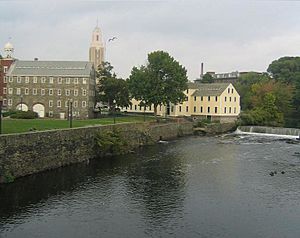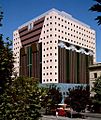National Register of Historic Places facts for kids

The National Register of Historic Places (NRHP) is the United States government's official list of important places. These places are worth protecting because of their history or special design. The list includes buildings, sites, structures, and objects. The National Park Service keeps this list.
The National Register was created in 1966. This happened because of a law called the National Historic Preservation Act. This law also set up how new places can be added to the list.
Today, there are over one million properties on the National Register. About 80,000 of these are listed on their own. The rest are smaller parts of larger "historic districts." These districts are areas with many historic buildings. Each year, about 30,000 new places are added. Some very special places are also called National Historic Landmarks.
Contents
What is the National Register?
The National Register of Historic Places is like a special hall of fame for historic sites. It helps people know which places are important to American history. It also encourages people to protect these places.
Why are places listed?
Places are listed on the National Register for many reasons. They might be important because of their history. For example, a building where a famous event happened. They could also be important because of their architecture or design. Sometimes, a place is listed because it shows how people lived long ago.
What kinds of places are listed?
The National Register lists many different types of "properties." These include:
- Buildings: Like old houses, schools, or churches.
- Sites: Such as battlefields, ancient villages, or even natural areas.
- Structures: Things like bridges, lighthouses, or monuments.
- Objects: This could be a statue or a special piece of equipment.
- Historic Districts: These are areas with many historic buildings or sites.
How does a place get listed?
Getting a place on the National Register involves a few steps. First, someone nominates the property. This could be the owner or a historical group. Then, experts review the nomination. They check if the place meets certain rules.
Who decides?
State historic preservation offices often help with the process. They work with the National Park Service. The National Park Service then makes the final decision. This ensures that only truly important places are added to the list.
Why is the National Register important?
Listing a property on the National Register has several benefits. It helps people learn about history. It also makes it easier to get help to preserve these places.
Protecting historic places
Being on the National Register helps protect historic places. It means that federal projects usually cannot harm these sites. It also makes people more aware of their value. This encourages communities to save and care for their historic buildings.
Learning about history
The National Register is a great tool for learning. It helps students and families discover important parts of American history. Many listed sites are open to visitors. This allows people to experience history firsthand.
Images for kids
-
Old Slater Mill, a historic district in Pawtucket, Rhode Island, was the first property listed in the National Register, on November 13, 1966.
-
S. R. Crown Hall is listed for its link to architect Ludwig Mies van der Rohe and modern design.
-
Round Barns in Illinois Thematic Resources includes 18 structures across the state.
-
A National Register of Historic Places plaque at the Robert E. Howard Museum in Cross Plains, Texas.
-
The Portland Building was added to the NRHP only 29 years after it opened.
-
Pecos Pueblo is one of many NRHP sites managed by the National Park Service.
-
The Illinois State Capitol is one of 44 U.S. state capitols on the NRHP.
-
College Hill Historic District is an example of a National Historic Landmark District.
-
The American Legation, Tangier is the only site on the NRHP in a foreign country.
-
Walden Pond is an example of a natural site listed on the NRHP.
-
The USS Wisconsin (BB-64) is one of many ships listed on the NRHP.
See also
 In Spanish: Registro Nacional de Lugares Históricos para niños
In Spanish: Registro Nacional de Lugares Históricos para niños

















